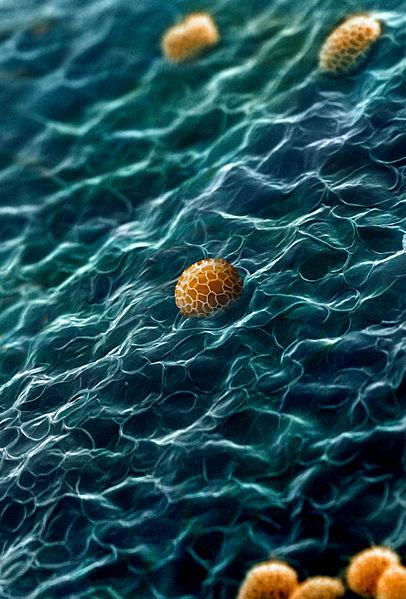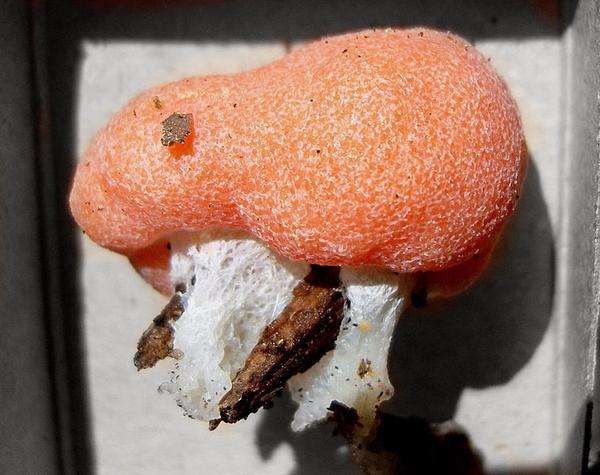
This beautiful photograph from Wikimedia Commons is a living organism magnified 2000 times by an electronic microscope, then colored using computer graphics. Can you guess what it is?
The description says: “Internal surface of the peridium of the rare myxomycete Tubifera dudkae is covered with folds resembling sea waves. Among them oval shaped reticulate spores occur.”
In other words, the blue waves and brown beads are part of the same organism, a slime mold called Tubifera dudkae. It is a rare member of the Myxomycete class. I don’t know if it occurs in North America but I do know it lives in Crimea (thanks to the photos from Wikimedia Commons) and in Tasmania, Australia (thanks to the Myxomycetes website by Sarah Lloyd, an expert in slime molds).
In the photo, the blue waves are the inner surface of the protective layer that holds the spores until they’re ready to release. This layer is called the peridium.
The brown beads with squiggly lines on them (i.e. reticulated) are the spores.
Here’s what this slime mold looks like from the outside at normal size, sitting in a matchbox.

And here’s the amazing thing: Are slime molds plants or animals?
Neither. They’re not even fungi. Slime molds are such weird organisms that scientists keep changing their minds about their classification. Here’s why, with thanks to Ann Jone’s article The Blob:
- In their reproductive stage, slime molds release spores.
- When the spores settle down they become one-celled organisms similar to amoebas that move around looking for food. They don’t need to swim in water to do this.
- At some point in their life cycle, the amoeba-like individuals are drawn to each other and meld into one big cell with millions of nuclei. Yes, there’s only one cell wall. This cell is called a plasmodium and it’s slimy.
- The plasmodium can move! In fact it oozes across the forest looking for food: bacteria, fungi, other slime molds. Some slime molds can stretch 10 feet.
- Though they have no brain, slime molds remember where they’ve been and don’t go back there.
Watch a slime mold move in this Deep Look video on YouTube.
Read more about slime molds in Ann Jone’s Australian radio article: The Blob, but smaller: Tasmania’s slime molds.
And learn about Sarah Lloyd, a birder, gardener, and self-taught slime mold expert who lives in the wet eucalypt forest of northern Tasmania.
(Featured photo from Wikimedia Commons; click on the image to see the original)
p.s. I’m using the American English spelling of mold, which is also spelled mould.